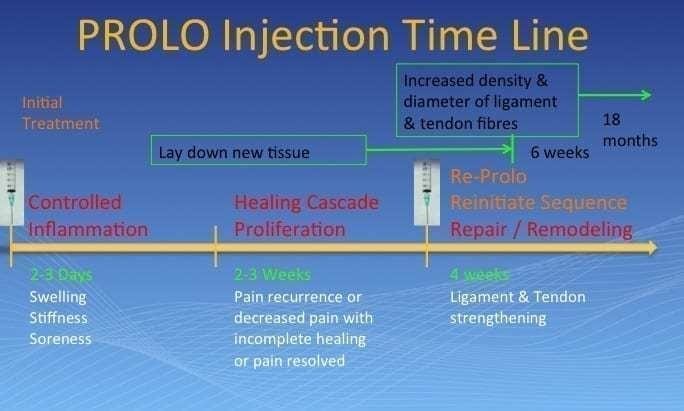PROLOTHERAPY
WHAT IS PROLOTHERAPY?
Prolotherapy involves injecting a proliferative solution into damaged tendon or ligament attachment sites—such as joints or bones—to stimulate the body’s natural healing process. It is also known as “nonsurgical ligament reconstruction.” The term “prolo” comes from “proliferation,” reflecting the treatment’s role in encouraging the growth of new ligaments, tendons, and cartilage in areas affected by weakness, laxity, or excessive scar tissue.
HOW DOES IT WORK?
Prolotherapy initiates a controlled inflammatory response at the injection site, activating the body’s wound-healing cascade. This increases blood flow and brings nutrients and growth factors to the area, prompting the production of new collagen—the key structural protein in ligaments and tendons. As this collagen matures, it tightens, resulting in stronger, more stable tissues.
WHAT SOLUTION IS INJECTED?
The injected solution typically includes dextrose (a sugar-based proliferant) and procaine (a local anesthetic). The dextrose concentration exceeds that of blood, triggering the desired healing response. Procaine provides temporary pain relief and can help confirm the diagnosis through immediate symptom improvement. Additional agents such as Vitamin B12, human growth hormone, or plant-based stimulants may also be included.
HOW MANY TREATMENTS ARE NEEDED?
Treatment needs vary depending on the severity of the injury, the area being treated, and individual healing rates. Most patients require 3–6 sessions per affected area, spaced out with time for recovery and proper nutrition. In more severe cases, 6–10 treatments may be necessary. Once treatment begins, your response will guide the ongoing plan.
Without prolotherapy, natural healing of ligaments may restore only up to 60% of original strength and take 6–12 months. With prolotherapy administered every two weeks, healing can be significantly accelerated—often within 1–2 months.
Unlike steroid injections—which suppress inflammation and may lead to tissue weakening over time—prolotherapy works by enhancing the body’s natural repair mechanisms, offering long-term benefit with minimal side effects.
PAIN CONDITIONS BENEFITED BY PROLOTHERAPY
- Musculoskeletal Injury – New or Old!
- Athletic injuries: ligament & tendon injuries, sprains, strains, tears
- Overuse injuries: golfer’s elbow, tennis elbow, shoulder tendinitis & rotator cuff, achilles tendinitis, plantar fasciitis, carpal tunnel
- Low back pain: musculoskeletal tension, sciatica, arthritis, herniated and degenerative discs
- Arthritis pain: back, hip, knees, shoulders, hands, wrists, feet
- Sacroiliac (SI) joint disorders
- Weak, loose, unstable joints: hypermobility, subluxations, nerve impingement
- Whiplash injuries: neck, upper back, shoulders, low back
- AND MORE…
“ The ligament and tendon tissue which forms as a result of Prolotherapy is thicker and stronger than normal tissue – up to 40% stronger in some cases.”

PLATELET RICH PLASMA (PRP) THERAPY – A LEADING NON-SURGICAL TREATMENT FOR JOINT AND TENDON INJURIES
Platelet-Rich Plasma (PRP) therapy is a natural treatment that accelerates healing in chronic injuries by tapping into the body’s own regenerative capabilities.
As a cornerstone of regenerative medicine, PRP has gained significant traction in recent years. Backed by growing research, it has become an effective treatment option for a variety of joint, tendon, and muscle issues. What makes PRP unique is its innovative yet natural approach—using your own blood platelets to support healing in areas traditionally treated with rest, ice, or anti-inflammatory drugs.
PRP has become especially popular among elite athletes—including professional golfer Tiger Woods—for conditions like osteoarthritis, tendonitis, and other chronic injuries.
WHAT IS PRP AND HOW DOES IT WORK?
PRP, or Platelet-Rich Plasma, is derived from your own blood and contains a high concentration of platelets. These platelets are rich in growth factors and bioactive proteins that are essential for kickstarting and accelerating the body’s repair processes.
When PRP is injected directly into an injured area, it triggers a natural healing response. The growth factors in PRP stimulate stem cell activity, promote the formation of new blood vessels, encourage collagen and tissue regeneration, and aid in bone repair. This is especially beneficial for areas like joints and tendons, which normally have limited blood supply.
The procedure is typically well-tolerated, relatively painless, and takes around an hour from start to finish.
HOW MANY TREATMENTS ARE NEEDED?
PRP often yields stronger results than traditional prolotherapy. The number of treatments required depends on the severity and nature of the injury, but many patients experience significant improvement after just 1–2 sessions, with most requiring only 2–3 treatments on average.
BENEFITS OF PRP
PRP healing effects have been proven to:
- Outlast conventional therapies, like cortisone or hyaluronic acid injections.
- Not only does it relieve pain; it actually helps to heal the underlying issue, with noticeable, long-term benefits within six months.
- Platelet rich plasma has no known negative side effects, (as it comes from your own body!)
- Healing benefits can be increased with additional treatments, such as neural therapy, cold laser therapy, massage, etc., although they’re not necessarily required.
Clinical studies show that PRP results in significant improvements, statistically and clinically including a reduction or resolution of pain, improved physical function and reduced stiffness. Multiple studies support this specifically for knee injuries. Some studies indicate that improvements can occur within six weeks of the first injection.
IS PRP RIGHT FOR YOU?
You may want to consider a PRP treatment if you’re experiencing:
- Mild to moderate osteoarthritis (in most joints, but especially the knees, hips or shoulders)
- Lateral and medial epicondylitis (tennis and golfer’s elbow)
- Rotator cuff tendonitis or partial tears
- Any other common tendon, muscle and ligament issues
It’s important to note that not all PRP treatments are created equal. For the best results, seek care from a physician who uses advanced medical equipment and lab-grade preparation methods to ensure optimal platelet concentration.
An initial consultation and physical assessment with your Naturopathic Doctor will help determine if PRP is the right approach for you.
Platelet-Rich Plasma therapy is currently available with Dr. Emina Jasarevic, ND.



